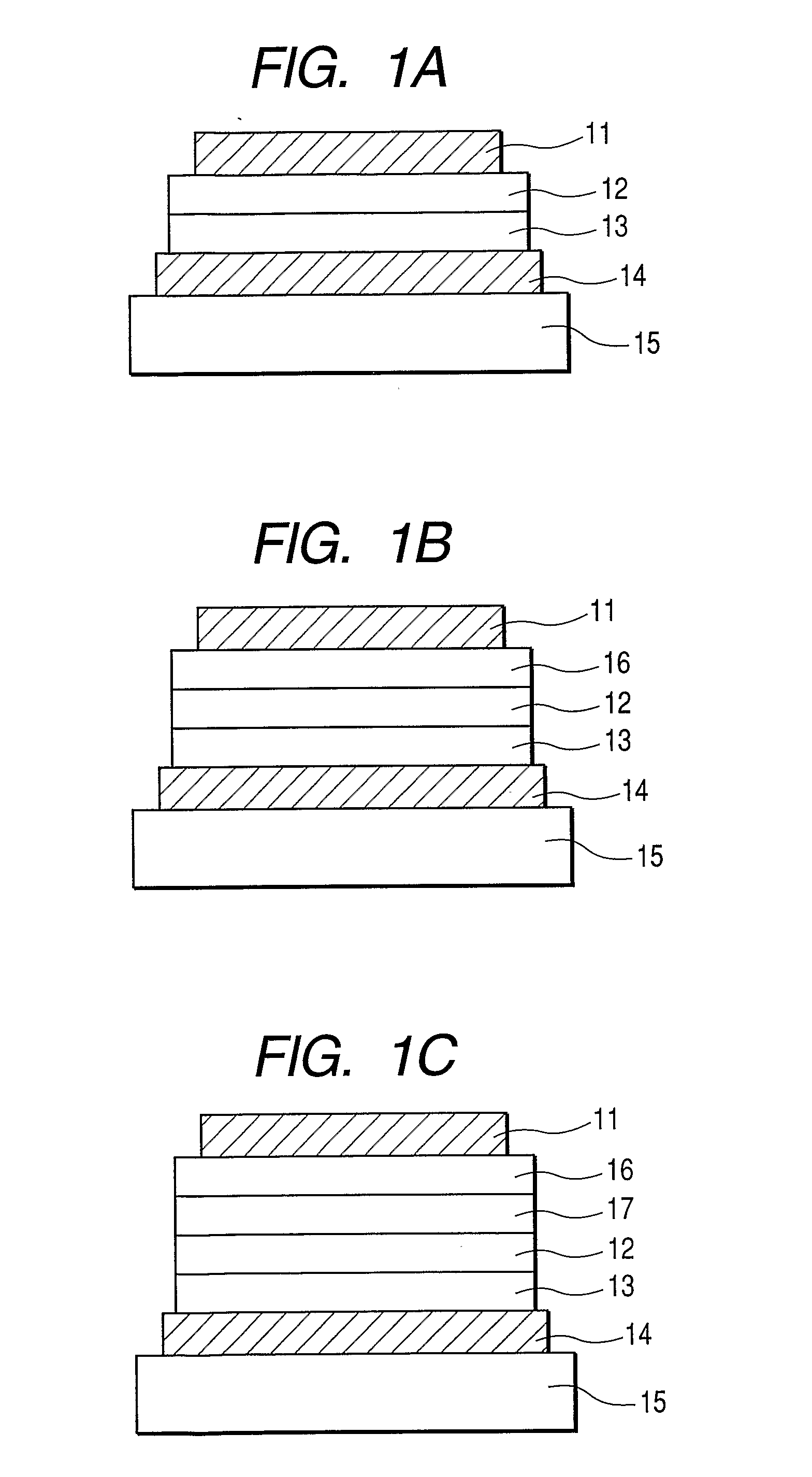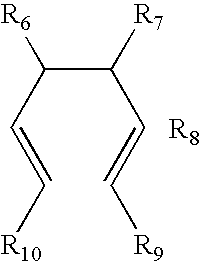Compound and organic electroluminescent device using same
- Summary
- Abstract
- Description
- Claims
- Application Information
AI Technical Summary
Benefits of technology
Problems solved by technology
Method used
Image
Examples
example 1
Synthesis of Exemplified Compound No. X-25
[0075]
[0076] 1 g (1.35 mmole) of Compound A, 672 mg (3.39 mmole) of 2-biphenylboric acid, 156 mg of Pd(PPh3)4, 20 ml of toluene, 10 ml of ethanol, and 20 ml of a 2M aqueous solution of sodium carbonate were fed into a 100-ml round-bottomed flask, and the whole was stirred at 80° C. for 8 hours in a stream of nitrogen. After the completion of the reaction, the resultant was extracted with toluene, and the organic layer was dried with magnesium sulfate. After that, the drying agent was filtered and the solvent was distilled off. The residue was dissolved into chloroform, and the solution was separated and purified by means of alumina column chromatography, followed by .recrystallization from toluene. The resultant crystal was vacuum-dried at 120° C., and the resultant was sublimated and purified to give 700 mg of Exemplified Compound No. X-25 (58% yield).
[0077] 882.4 as M+ of the compound was confirmed by means of Matrix Assisted Laser Desorp...
example 2
[0081] In this example, a device having three organic layers shown in FIG. 1B was used as a device structure.
[0082] ITO (as the transparent electrode 14) having a thickness of 100 nm was patterned on a glass substrate (as the transparent substrate 15). The following organic layers and electrode layers were successively formed on the ITO substrate by means of vacuum evaporation according to resistive heating .in a vacuum chamber having a pressure of 10−5 Pa such that the opposing electrode area was 3 mm2. Hole-transporting layer 13 (50 nm): α-NPD Light-emitting layer 12 (50 nm): [Host] Exemplified Compound No. X-25, [Guest] Ir(4mopiq)3 (weight ratio: 4%) and Ir(bq)3 (weight ratio: 8%) Electron-transporting layer 16 (50 nm): Bphen (manufactured by DOJINDO LABORATORIES) Metal electrode layer 1 (1 nm): KF Metal electrode layer 2 (130 nm): Al
[0083] The current-voltage characteristics of the EL device were measured by using a microammeter 4140B (manufactured by Hewlett-Packard Developme...
example 3
Synthesis of Exemplified Compound No. X-23
[0090]
[0091] 2 g (3.13 mmole) of Compound B, 1.38 g (6.89 mmole) of 2-bromophenylboric acid, 400 mg of Pd(PPh3)4, 20 ml of toluene, 10 ml of ethanol, and 20 ml of a 2M aqueous solution of sodium carbonate were fed into a 100-ml round-bottomed flask, and the whole was stirred at 80° C. for 4 hours in a stream of nitrogen. After the completion of the reaction, the resultant was extracted with toluene, and the organic layer was dried with magnesium sulfate. After that, the drying agent was filtered and the solvent was distilled off. The residue was dissolved into chloroform, and the solution was separated and purified by means of silica gel chromatography, followed by recrystallization from toluene, to thereby give 1.37 g of Compound C (63% yield).
[0092] 694.1 as M+ of the compound was observed by means of Matrix Assisted Laser Desorption / Ionization-Time of Flight Mass Spectrometry (MALDI-TOF MS).
[0093] In addition, the structure of the compo...
PUM
| Property | Measurement | Unit |
|---|---|---|
| Temperature | aaaaa | aaaaa |
| Temperature | aaaaa | aaaaa |
| Temperature | aaaaa | aaaaa |
Abstract
Description
Claims
Application Information
 Login to View More
Login to View More - R&D
- Intellectual Property
- Life Sciences
- Materials
- Tech Scout
- Unparalleled Data Quality
- Higher Quality Content
- 60% Fewer Hallucinations
Browse by: Latest US Patents, China's latest patents, Technical Efficacy Thesaurus, Application Domain, Technology Topic, Popular Technical Reports.
© 2025 PatSnap. All rights reserved.Legal|Privacy policy|Modern Slavery Act Transparency Statement|Sitemap|About US| Contact US: help@patsnap.com



